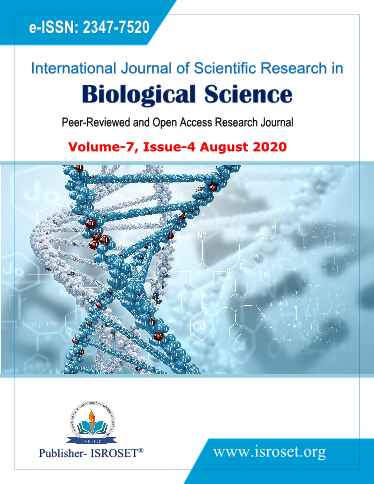Social Media Usage, Eating Habits and Nutritional Status of School-Going Adolescents: A Descriptive Study
Keywords:
Social media, Adolescents, Eating habits, obesity, hypertensionAbstract
Influence of social media on eating habits of adolescent children (increased number of meals taken other than home; consumption of junk foods in the forms of snacks and soft drinks) could increase their chances of developing health risks in adulthood such as obesity. Therefore, we aimed to assess the prevalent eating habits; physical activity, and use of social media among school-going adolescents. A cross-sectional descriptive study was carried out among 150 adolescents studying in a private school, located in the suburban area of Faridabad. Data related to social media usage, eating habits and physical activity was collected using self-administered questionnaires. The purposive sampling strategy was used to recruit students from classes eight to ten aged between 12-18 years. A total sample of 150 students comprised 63% boys and 37% girls. The mean age of the students was 14.2?1.12 years. There was a significant difference between the BMI of students who spent ≤ 3 hours and > 3 hours on social media as mean BMI was 18.13?2.64 and 19.59?3.94 respectively with the increase in time spent on social media. Frequent consumption of food items high in salt, sugar, and fat was also seen. Increased time spent on social media sites just for fun activity would be reducing the nutritional status of adolescents. Less intake of nutritious food might also cause micronutrient deficiency. We need to conduct more such studies to find the health effects of excess social media usage
References
Rachana.R, Pooja.T, ?Emerging trend of online social networking among adolescents- an analysis?, An International Multidisciplinary Research e-Journal, vol .1, Issue 2, pp 50-56, 2015.
Ramesh Masthi, N. R., Pruthvi, S., & Phaneendra, M. S, ?A Comparative Study on Social Media Usage and Health Status among Students Studying in Pre-University Colleges of Urban Bengaluru?, Indian journal of community medicine: official publication of Indian Association of Preventive & Social Medicine, vol.43, Issue.3, pp.180?184, 2018
M .M.Singh, A. Mohammad, S Sabbarwal," social media usage: positive and negative effects on the lifestyle of Indian youth?, Iranian Journal of Social Sciences and Humanities Research, Vol.5, Issue. 3, pp.123-127, 2017.
WHO Maternal, newborn, child, and adolescent health. Adolescent development: A critical transition.
Adolescence An Age of Opportunity by UNICEF, 2011.
D.Saxena, T. Puwar T, S.Yasobant, ? Noncommunicable diseases among school-going adolescents: A case study on the prevalence of risk factors from Sabarkantha District of Gujarat?, India. Indian Journal of Community Medicine, Vol. 43, Issue. 5, pp. 33-37, 2018.
R.Chudasama, T.Eshwar, S.Eshwar, et al., "Prevalence of obesity and overweight and their comparison by three growth standards among affluent school students aged 8?18 years in Rajkot", Indian Journal of Public Health, Vol.61, Issue.1, pp. 51-54, 2017.
Y.Wang, T. Lobstein, ?Worldwide trends in childhood overweight and obesity?, International Journal of Pediatric Obesity, Vol.1, Issue. 1, pp.11-25, 2006.
P.Kotecha, S. Patel, R.Baxi, et al., ?Dietary Pattern of School Going Adolescents in Urban Baroda, India?, Journal of Health, Population, and Nutrition, Vol. 31, Issue. 4, pp.490-496, 2014.
E.Neter, R.B.Melaman, A.Tavor, ?The effect of exposure to food in social networks on food cravings and external eating?, Ruppin academic, Israel, pp.1-36, 2018., ?The effect of exposure to food in social networks on food cravings and external eating?, Ruppin academic, Israel, pp.1-36, 2018.
C.Holmberg, E.J Chaplin, T.Hillman, et al., ?Adolescents` presentation of food in social media: An explorative study?, Appetite, 99, pp.121-129, 2016.
J.S.Bodenlos, B.M.Wormuth. ?Watching a food-related television show and caloric intake. A laboratory study?. Appetite; 61, 1, pp. 8‐12, 2013.
Global school-based health survey by the World health organization (WHO)
N.Shukla, M.Shukla, S.Ahmad, et al. ?Watching a food-related television show and caloric intake. A laboratory study?. A preliminary study on eating habits among school-going adolescent girls in barabanki district, Uttar Pradesh?, Sch. J. App. Med. Sci., 5, 1C, pp.184-187, 2017.
N.Stettler, T.Signer, P.Suter ?Electronic Games and Environmental Factors Associated with Childhood Obesity in Switzerland?. Obesity Research, Vol.12, Issue.6, pp.896-903, 2004.
R.Priyadarshini R. ?Impact of media on the physical health of urban school children of age group 11-17yrs in Chennai - A cross-sectional study", IOSR Journal of Humanities and Social Science, Vol. 9, Issue.5,pp.30-35, 2013.
M.Lyngdoh, B.S. Akoijam, S. Agui RK, et al. "Diet, physical activity, and screen time among school students in Manipur", Indian J Community Med, Vol.44, Issue. 2, pp.134-137, 2019.
D.Khajeheian, A.M. Colabi, N.B.A.K.Shah, et al. ?Effect of Social Media on Child Obesity: Application of Structural Equation Modeling with the Taguchi Method?, Int J Environ Res Public Health, Vol.15, Issue.7,pp.1343, 2018.
D.Park ,J. Lee , S.Han , ?Underweight: another risk factor for cardiovascular disease?A cross-sectional 2013 Behavioral Risk Factor Surveillance System (BRFSS) study of 491,773 individuals in the USA?,Medicine(Baltimore),Vol.96, Issue.48,pp.e8769, 2017.
A.Sahithi, S.V. Mane, S. Agarkhedkar. ?Use of Social Media and its Effects in School-Going Adolescents". Ind J Youth Adol Health, Vol.6, Issue.2, pp.20-25, 2019.
M.A.Carskadon, K.Harvey, P. Duke, et al. ?Pubertal changes in daytime sleepiness?, Sleep, Vol. 2, Issue.4, pp. 453-460, 1980.
A.Varghese, G. Mathew, A.Benjamin. ?A comparative study assessing sleep duration and associated factors among adolescents studying in different types of schools in an urban area of Kerala, India?, Indian Journal of Community Medicine. Vol.44, Issue.5, pp.10-13, 2019.
Downloads
Published
How to Cite
Issue
Section
License

This work is licensed under a Creative Commons Attribution 4.0 International License.
Authors contributing to this journal agree to publish their articles under the Creative Commons Attribution 4.0 International License, allowing third parties to share their work (copy, distribute, transmit) and to adapt it, under the condition that the authors are given credit and that in the event of reuse or distribution, the terms of this license are made clear.







